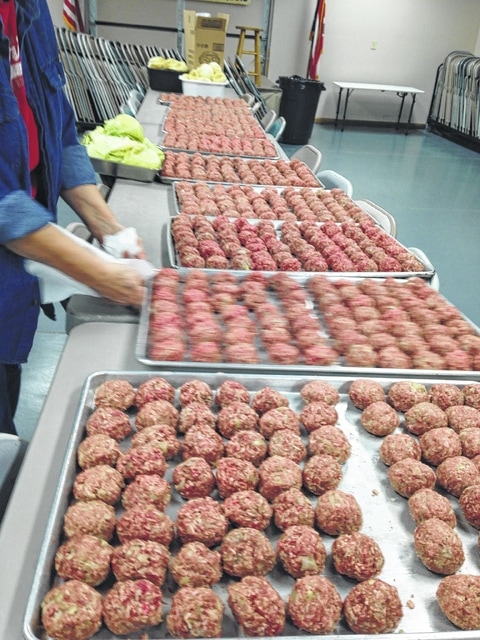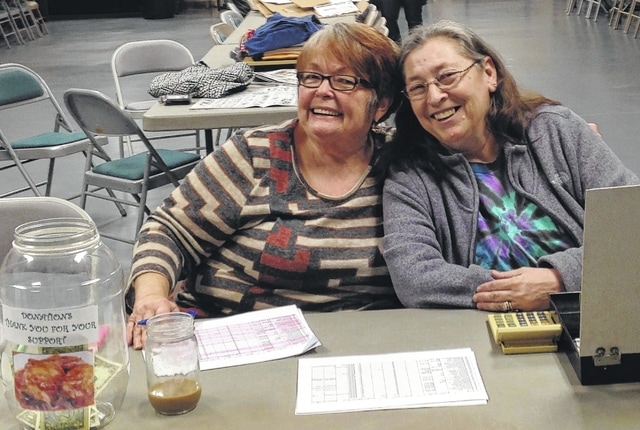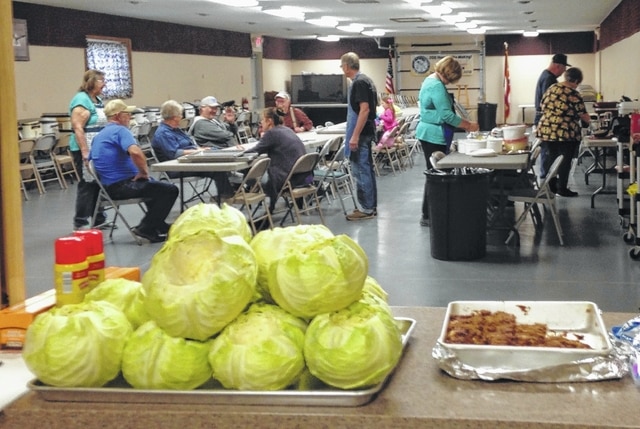


LEWISBURG — A dozen people in Lewisburg can turn cabbages, a cow, and camaraderie into a successful pop-up business that raises money to preserve history.
The people are members and friends of the Lewisburg Historical Society who volunteer to make and sell cabbage rolls to benefit the society.
The cabbages and cow are just a few of the ingredients they transformed into 1,175 cabbage rolls on Feb. 1. The rolls made their way onto the dinner tables of hundreds of local households the next day.
Diane Shrout, a leader in the historical society and a retired businesswoman, explains quite simply how the cabbage roll event began: “I like to cook … and we need money!”
This was just the second year the LHS sold cabbage rolls, a food tradition in nearby Dayton and surrounding communities. Several organizations prize the rolls for their connection to German heritage, and a handful of restaurants keep them on the menu.
No matter where you are, building a cabbage roll – not to mention more than a thousand of them — isn’t as easy as a serving up a hamburger or some chili. It takes planning, coordination, community outreach and a whole lot of sweat equity.
The planning and coordination are Mrs. Shrout’s specialties. Volunteers follow her instructions and recipe from shopping through cooking to collecting the $3 per roll that people pay to enjoy dinner.
Mrs. Shrout and her husband also owned the cow in question. It was ready for market, whether cabbage rolls were being made or not, so Mrs. Shrout sold some of the meat to the historical society at bargain prices. The cow became the ground beef that went into the rolls.
She and others shop for the best prices they can find on all the ingredients, which are then processed and assembled, with most of the work being done by hand by more than a dozen volunteers who assemble bright and early at the Tri-County North Community Center, 261 E. Clay St.
Giant bags of cabbages and dozens of large cans of tomato sauce line a hallway. Two sets of long tables in the main community room support dozens of roasters loaned for the occasion. Large packages of meat, dozens of eggs, containers of chopped onion, spices, and other ingredients are on tables on one side of the room awaiting their turns in blenders brought from home.
Here’s how it all works:
• Men take the cabbage heads and cut out the hard cores, leaving most of leaves unanchored.
• Women take the cabbages one by one, drop them into water that’s boiling on the four largest burners of the two stoves in the community center kitchen. As the cabbage cooks, the women peel off multiple layers of outer leaves.
• Others drain and sort the cooked leaves and cut out the small, hard flesh that attached each leaf to the head.
• After the cabbage cooking is well under way, a team of both men and women starts to assemble the filling using blenders to mix the ground beef from the Shrouts’ cow with sausage, chopped onions, eggs, rice and spices. (Last year some of the rice did not cook properly, so this year a switch was made to Minute Rice.)
• When each batch of filling is ready, scoopers divide it into equal small quantities and pass it on to rollers, whose palms form amazingly uniform small balls of filling. This year they fit 70 to a tray, and they filled 17 trays.
• Then the time comes to marry the leaves with their fillings. A wrapper takes a leaf, places a ball of filling at one end and folds the leaf up once to cover the meat mixture. The next fold takes both sides of the cabbage toward the center. Then the leaf is rolled until the filling is snug inside. “It’s just like wrapping a Christmas present,” Mrs. Shrout says.
• Then it’s time for the rolls to find a nice warm place in one of the roasters. All rolls are then doused in tomato sauce, and most roasters get healthy dollops of sauerkraut. (A minority of the rolls are cooked with no ‘kraut, but most of the crew can’t understand why anyone would want a cabbage roll without!)
Customers arrive the next afternoon at the community center to pick up their piping hot rolls. The most common greeting as someone steps through the door is a version of “It smells good in here!”
This year’s proceeds will help pay for the historical society’s storage building that was recently erected next door to the historic train station, just steps from the community center.
Even though this big job is done for the year, Mrs. Shrout doesn’t have much time to rest. She’s part of the team putting together Lewisburg’s Bicentennial cookbook, due out in 2018.




